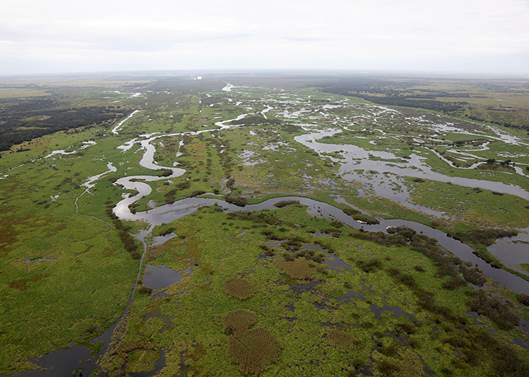by Randy Smith, SFWMD
Three years ahead of schedule, South Florida Water Management District (SFWMD) engineers have begun a test to retain additional water in the Kissimmee Chain of Lakes, which will reduce the flow of water into Lake Okeechobee. This critical step in the nearly $800 million public investment in Kissimmee River Restoration will allow scientists to measure the ecological benefits of this new operating plan for the river and its floodplain. This action is consistent with the SFWMD Governing Board’s direction to reduce freshwater releases from the Kissimmee Chain of Lakes into Lake Okeechobee and then to the Caloosahatchee and St. Lucie estuaries. “Holding water north in the Kissimmee Chain of Lakes provides the U.S. Army Corps of Engineers, which manages Lake Okeechobee, more flexibility when it comes to releasing water to the coastal estuaries,” said SFWMD Chairman Dan O’Keefe. “Beginning this operation early also allows us to test the Kissimmee Headwaters project to ascertain the benefits to the ecology of the river system.”
Ongoing Kissimmee River Restoration progress essentially has two parts:
- Backfilling the channelized river and returning it to traditional oxbows so that the floodplain can be hydrated to its natural state; and
- Holding water at higher elevations in the Kissimmee Chain of Lakes at the river’s headwaters and slowly releasing that water south to methodically inundate the river’s historic floodplain during the dry season.
Holding water north creates 100,000 acre-feet of water storage in the Kissimmee Chain of Lakes and thereby reduces water levels on Lake Okeechobee. This also provides for the gradual release of this water to the river that is vital to the ecology of newly restored sections of the river and better mimics natural, historic conditions.
Increasing water storage will also slow the flow of water to Lake Okeechobee, where currently, water can flow into the lake from the Kissimmee River and other watersheds up to six times faster than it can be released.
Background: Kissimmee River Restoration
The Kissimmee River once meandered for 103 miles through central Florida. Its floodplain, reaching up to three miles wide, was inundated for long periods by heavy seasonal rains. In the 1960s, the river was channelized by dredging a 30 foot deep straightaway through the river’s meanders creating the C38 canal. While the project delivered on the promise of flood protection, it also destroyed much of a floodplain dependent ecosystem that nurtured the river’s ecology. After extensive planning, construction for the Kissimmee River Restoration Project began in 1999 with purchasing sufficient land interests to retain water in the Kissimmee Chain of Lakes and backfilling 8 miles of the C38 canal. Three construction phases are now complete, and continuous water flow has been reestablished to 24 miles of the meandering Kissimmee River. Seasonal rains and flows now regularly inundate the floodplain in the restored area, as they did before channelization. The comprehensive restoration project will return flow to the river’s historic channel and restore about 40 square miles of river/floodplain ecosystem. During the next three years, backfilling of the remaining 6 ½ miles of canal will be complete, a new weir will be constructed and the project will begin operating.







